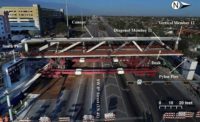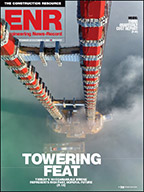The National Transportation Safety Board says a distracted pilot driver speaking on a hands-free cellular phone, inadequate clearance signage and a trucker unaware of lane rules share the blame for the span collapse of Washington's Skagit River bridge last year.
The state's automated oversize-load permitting system also needs updating, says the NTSB's report on the May 23, 2013, incident, in which a truck hauling an oversize load struck the Interstate 5 Skagit River bridge, causing a span to collapse 38 ft into the river.
"What this investigation uncovered were multiple gaps in multiple systems and repeated occurrences of similar bridge strikes," notes Christopher Hart, NTSB acting chairman. "Many other bridges," Hart adds, "remain at risk for high-load strikes."
The Mullen Trucking vehicle's load of 15 ft, 11 in., was six inches over the lane limit, which led to the strike, the report says. Another contributing factor was the lack of signage detailing heights by lane, as per 50-year-old federal guidelines, which created a lack of awareness of route needs. In addition, the trucking company input its route online and received a permit automatically, without a route review by staff. The report says that, of the 22 bridges on Washington's interstate system with a similar design, "none have low-clearance signs or give any indications of the lane oversized vehicles should use." The NTSB urged the Federal Highway Administration to standardize highway signage to include overheight vehicles and urged the Washington State Dept. of Transportation to "strengthen its permitting process."
WashDOT says it "has already begun acting on NTSB's recommendations for improving access to data for the freight industry to better plan travel routes of oversized loads."
The pilot driver claims her 16-ft pole did not strike any beams, but the report cites a witness who says he saw the pole hit the bridge at least four times. The NTSB also supports general bans on phone use for pilot drivers.




